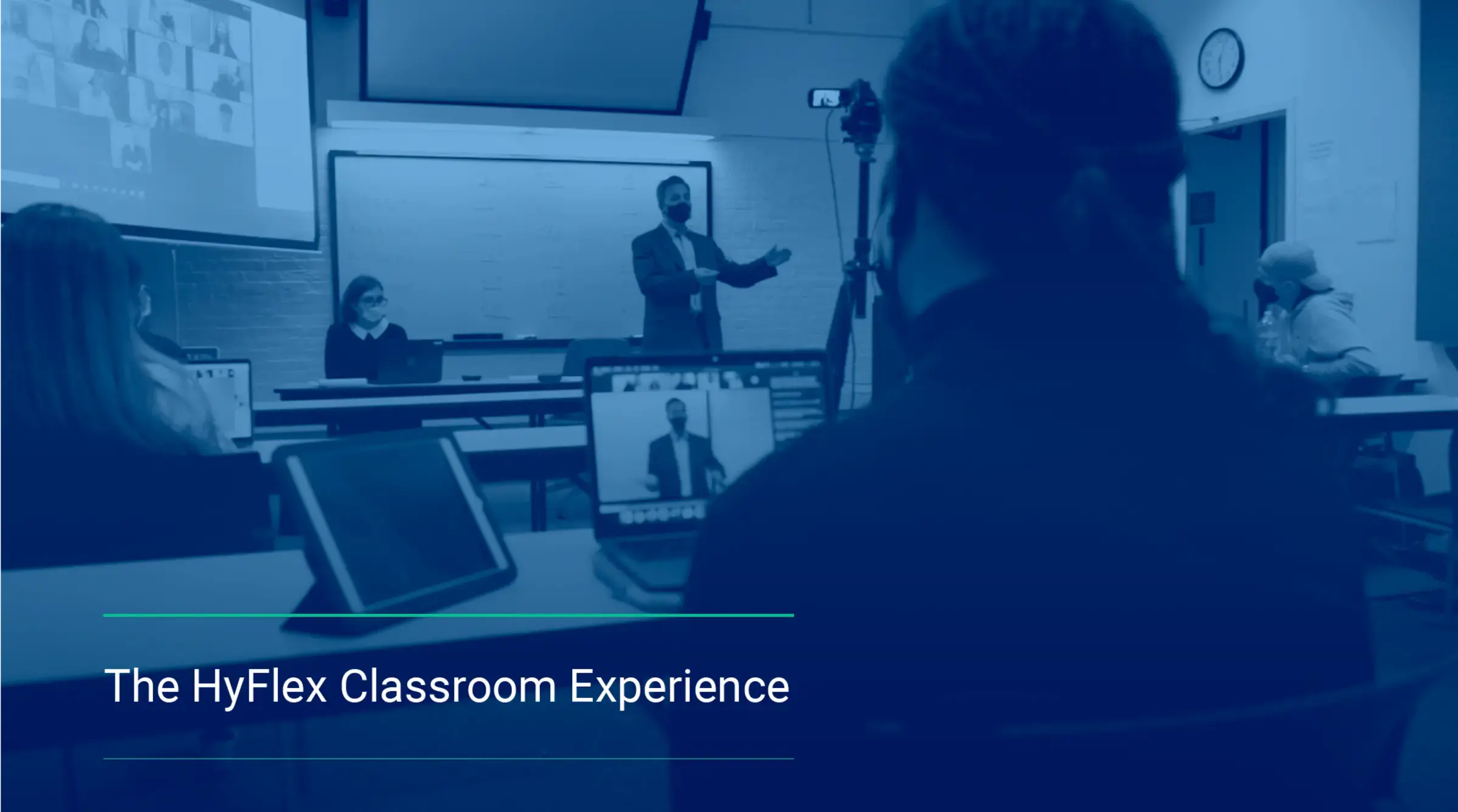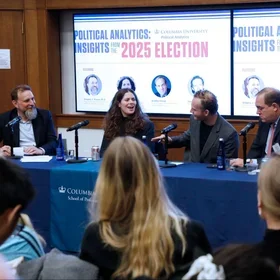Now in his first term back on campus since classes shifted to online modality in March, Gabriel Amor reflects on how he’s refined his HyFlex instruction methods for the Strategic Communication Management course, the increasingly business-critical need for strategic communicators and how his students inspire him.
What do you enjoy most about returning to campus?
It’s fantastic being back on campus. I love walking around and seeing students out and about — everyone’s practicing social distancing, but you see people eating at tables, studying in small groups outdoors. It’s an energy you feel that can’t be replicated anywhere other than on this campus. Columbia is a special place; our students are highly motivated and intellectually curious, so there’s this hum in the air. Physically, it’s a beautiful campus that looks straight out of a Hollywood film. And it’s great to see people around after being shut in for so long!
Getting back in the classroom is amazing. People who teach generally enjoy being around students and that is certainly the case with me: I thrive when I am around my students. And this semester more than ever, they’re so happy to be in the classroom. The students in my physical classroom have overcome numerous obstacles to get to New York, and they are eager to meet faculty and classmates face to face. When someone goes through all that trouble — obtaining visas and quarantining for two weeks, for example — they really want to be in the classroom. These are passionate individuals who have a lot to offer, which makes for an incredibly dynamic classroom environment.
It’s an energy you feel that can’t be replicated anywhere other than on this campus."
How have you adjusted to the HyFlex learning model?
The M.S. in Strategic Communication fits my teaching style — I integrate a wide range of interactivity into my class. We have team exercises most weeks, and I make sure each student has an opportunity to speak at every class meeting. I’m mastering how to best deliver these learning activities across the two cohorts — the in-person students and those on Zoom. For example, I ensure that project teams are a mix of both cohorts so those students who are in-person and those who are online learn from each other.
I feel privileged to teach at Columbia SPS because the resources available here enable me to create an equivalency of learning experiences across modalities. My goal is for all students, whether in the online classroom or the physical one, to reap the same benefits and come away with the same learning outcomes."
By now we all know how to work with Zoom (e.g., students bring their headphones and mute their mics). It turns out that the online audio and video quality is excellent, so that is an added benefit of mixed teams: everyone communicates via the same, clear A/V channel. It's a fascinating (and new) experience to stand in the classroom while observing students collaborate with their peers via this technology. I find that using the right tools in the right way is key. For instance, knowing when and how to properly share screens or pin videos so the person who is speaking remains the central focus on screen. Kelly Moffitt, my Course Associate, makes sure that happens. And Cora Li, the Video Assistant, continually shifts her camera so everyone online can see what is going on in the physical classroom, whether that means following my note-writing on the whiteboard or tracking students as they make presentations. Together, these strategies create the sense that our online students are right there in the classroom. Actually, you can hear online students better than the students in the classroom. For one thing, online students don’t wear masks so they come across more clearly. But the critical detail is that there are two powerful speakers in the room, meaning that anyone speaking via Zoom is heard loud and clear, and their presence is really felt in the classroom.
I feel privileged to teach at Columbia SPS because the resources available here enable me to create an equivalency of learning experiences across modalities. My goal is for all students, whether in the online classroom or the physical one, to reap the same benefits and come away with the same learning outcomes.
One thing that I have found unique about this experience is having the class sessions recorded. As a result, I now do something that most people dislike doing: I watch videos of myself teaching after each class. It’s hard to watch yourself on video! But I’ve learned so much by reviewing the recordings. They help me assess how the audio comes across, and whether the video is keeping up with me — I tend to move about the classroom. After watching the recordings, I toned that down because when you’re on video, everything is amplified (I am also a performer, so I have some experience in front of the camera) and sound quality can suffer if you move quickly. In addition, I now pause longer to allow online students more opportunity to respond, mindful that there may be a small delay, and I call on online students more regularly. Reviewing the recordings really allows me to assess how students are responding and whether they’re “getting it,” and this in turn enables me to quickly tweak the lesson plan and activities for the next class. Admittedly, it’s sometimes hard watching myself on video, but doing so provides me with information that I can use to make each class better than the last.
Another tool that I now use is online discussion groups. Kelly and I will select a trending topic in the news that relates directly to what we’ll be doing in class that week and ask students to respond to it on Canvas (our online learning management system). Everyone joins the discussion on Canvas, so there's no separation between online and in-person students. I reply to every entry, so that each student receives feedback and becomes part of the larger dialogue. And what a robust dialogue! We spend the first ten minutes of each class session going over what students posted in the online discussion group. Kelly and I will select comments that we find interesting and call on the authoring students to elaborate on their initial thoughts.
What’s been most surprising this term?
I think what took me and my students by surprise is the realization of the growing importance that communication professionals play in our society. Kelly put together a mini case study examining how the San Francisco 49ers and the Guggenheim Museum handled the Black Out Tuesday social media campaign for Black Lives Matter. We asked students to analyze what happened, and to think about how these organizations might have responded differently. It began as an animated discussion on authenticity that shifted focus to the importance of research and strategy (which are key learnings from our class). I pointed out that it is very difficult to respond strategically when under tremendous pressure. I asked my students to imagine sitting in a conference room with the 49ers’ leadership demanding that they “do something fast!” for Blackout Tuesday. How would the students (really) respond to that? It’s one thing to critique how these organizations responded — and they were good critiques — I also wanted them to think about how they might respond under the same circumstances. Would they be able to incorporate their focus on authenticity into action in the fast-moving world of social media?
[T]he consequences of a poorly-aligned communication strategy are strikingly apparent now. Today, consumers will boycott you, they will troll you on social media — whether that “you” is an individual or an organization. That new reality became even more apparent during this past year as the world contended with pandemics, social unease, climate issues, etc."
In the past, the strategic communicator was not always seen as a key player in some organizations; now it’s become a critical role at the C-Suite level because communication can make or break an organization’s reputation. My students are starting to see the connection between their chosen profession and an organization’s success. I want them to think about what that will mean for them going forward. To that end, I’m transparent about my own experience in the corporate world. While at American Express, for example, I couldn’t always go through all of the recommended steps; too often, I did not have the luxury of time in creating a communication plan because I was tasked to get it done now. I think that reality has evolved because the consequences of a poorly-aligned communication strategy are strikingly apparent now. Today, consumers will boycott you, they will troll you on social media — whether that “you” is an individual or an organization. That new reality became even more apparent during this past year as the world contended with pandemics, social unease, climate issues, etc.
Last week, one of my students shared how much he appreciated that Columbia SPS “provided tons of information” about how the University was managing in the pandemic. He had initially opted to be an online student but has since decided to attend class in-person because he feels safe doing so after weeks watching me conduct class via Zoom. That is the power of communication! As a member of the SPS community, it’s great to hear that our communication strategy and transparency made this student feel informed.
[O]ne of my students shared how much he appreciated that Columbia SPS 'provided tons of information' about how the University was managing in the pandemic. He had initially opted to be an online student but has since decided to attend class in-person because he feels safe doing so after weeks watching me conduct class via Zoom."
What does it mean to you to be a member of the Columbia SPS community?
It means being part of an institution that I can believe in. It means being part of a community of people who are asking questions. It means that while we may not always have the answers to tough questions, there are people here who are working on them. I’ve worked in organizations where those principles were paid lip service, but Columbia is different. As a research institution, there is a commitment to truth, to problem-solving. For me, being around faculty and students who really want to make a difference is awe-inspiring. This generation of students is keenly focused on authenticity and social justice. Time will tell if their contributions in the workplace will lead to sustainable change, but based on my experience teaching at SPS, I have confidence in them.



